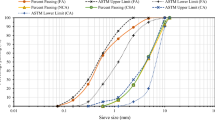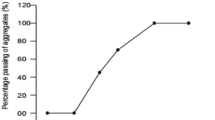Abstract
The significant contribution of the carbon dioxide emission from the production of Portland cement which is the main binder used in concrete has called for an imminent need to find environmentally friendly materials as alternatives. The availability of large quantities of agricultural wastes such as coconut shell in most developing countries opens a pathway to explore how these materials can be recycled into concrete as the binder composition. The combustion of most solid agricultural wastes results in the production of ash which can be used to replace Portland cement as a binder in concrete. This paper presents the results from the experimental investigation of the effect of coconut shell ash on the workability, mechanical properties, and embodied carbon of concrete. A total of five mixtures were made with coconut shell ash replacing Portland cement up to 20%. Results from this paper showed that coconut shell ash can be incorporated into concrete mixtures to reduce its embodied carbon. A reduction in embodied carbon of about 15% was achieved when 20% of Portland cement was replaced with coconut shell ash. The incorporation of coconut shell ash into concrete mixtures also resulted in an increase in the mechanical properties up to 10% replacement of Portland cement. The compressive, tensile, and flexural strength of mixtures incorporating 10% coconut shell ash as replacement of Portland cement is 12%, 10%, and 9% higher than that of the control mixture without coconut shell ash.










Similar content being viewed by others
Data availability
The datasets used and/or analyzed during the current study are available from the corresponding author on reasonable request.
References
(BS) BS (1997) BS 8110: Structural use of concrete - Part 1: code of practice for design and construction. Br Stand
ACI committee 318 (2011) Building code requirements for structural concrete and commentary (ACI 318 M-11)
Adesina A (2018) Concrete sustainability issues. In: 38th cement and concrete science conference, UK. London
Adesina A, Atoyebi OD (2020) Effect of crumb rubber aggregate on the performance of cementitious composites: A review. IOP Conf Ser Earth Environ Sci 445. https://doi.org/10.1088/1755-1315/445/1/012032
Adesina A, Awoyera P (2019) Overview of trends in the application of waste materials in self-compacting concrete production. SN Appl Sci 1. https://doi.org/10.1007/s42452-019-1012-4
Akinyemi BA, Adesina A (2020) Recent advancements in the use of biochar for cementitious applications: a review. J Build Eng:101705. https://doi.org/10.1016/j.jobe.2020.101705
Al-Sibahy A, Edwards R (2012) Mechanical and thermal properties of novel lightweight concrete mixtures containing recycled glass and metakaolin. Constr Build Mater 31:157–167. https://doi.org/10.1016/j.conbuildmat.2011.12.095
Andrew RM (2018) Global CO2 emissions from cement production. Earth Syst Sci Data 10:195–217. https://doi.org/10.5194/essd-10-195-2018
Arena N, Lee J, Clift R (2016) Life Cycle Assessment of activated carbon production from coconut shells. J Clean Prod 125:68–77. https://doi.org/10.1016/j.jclepro.2016.03.073
Awoyera PO, Adesina A (2020) Plastic wastes to construction products: status, limitations and future perspective. Case Stud Constr Mater 12:e00330. https://doi.org/10.1016/j.cscm.2020.e00330
Awoyera PO, Adesina A, Gobinath R (2019) Role of recycling fine materials as filler for improving performance of concrete - a review. Aust J Civ Eng
Batayneh M, Marie I, Asi I (2007) Use of selected waste materials in concrete mixes. Waste Manag 27:1870–1876. https://doi.org/10.1016/j.wasman.2006.07.026
Bheel N (2020a) Use of marble powder and tile powder as cementitious materials in concrete. 10:5448–5451
Bheel N (2020b) Rice husk ash and fly ash effects on the mechanical properties of concrete. 10:5402–5405
Bheel N, Adesina A (2020) Influence of binary blend of corn cob ash and glass powder as partial replacement of cement in concrete. Silicon. https://doi.org/10.1007/s12633-020-00557-4
Bheel N, Talpur SM (2020) Effect of sugarcane bagasse ash and lime stone fines on the mechanical properties of concrete. 10:5534–5537
Bheel N, Meghwar SL, Abbasi SA et al (2018a) Effect of rice husk ash and water-cement ratio on strength of concrete. Civ Eng J 4:2373. https://doi.org/10.28991/cej-03091166
Bheel N, Meghwar SL, Sohu S et al (2018b) experimental study on recycled concrete aggregates with rice husk ash as partial cement replacement. Civ Eng J 4:2305. https://doi.org/10.28991/cej-03091160
Bheel N, Abbasi RA, Sohu S et al (2019a) Effect of tile powder used as a cementitious material on the mechanical properties of concrete. Eng Technol Appl Sci Res
Bheel N, Ahmed F, Lal S, Wahab A (2019b) Millet husk ash as environmental friendly material in cement concrete millet husk ash as environmental friendly. Mater Cement Concrete 2018:153–158
Bheel N, Meghwar Santosh Kumar, Abbasi RA, et al (2019c) Use of sugarcane bagasse ash as a cement replacement materials in concrete. In: International Conference on Sustainable Development in Civil Engineering
British Standard (2009a) Testing hardened concrete - Part 5: flexural strength of test specimens. BS En 12390-52009
British Standard (2009b) Testing hardened concrete - Part 6: tensile splitting strength of test specimens. BS EN 12390-62009
British Standards Institute (1982) BS 5075-1: 1982 Concrete admixtures - Part 1: specification for accelerating and retarding water reducing admixtures. Br Stand B
British Standards Institution (2000) BS EN 12390-7:2000 Part 7: Density of hardened concrete
BS EN 12350-1:2009 (2009) Testing fresh concrete. slump-test. Eur Norms
BS EN 12390-13 (2013) Testing hardened concrete - Part 13: determination of secant modulus of elasticity in compression. BSI - Br Stand Inst
BS EN 12390-2001 Part 3 (2002) Testing hardened concrete: compressive strength of test specimens. Br Stand Inst
BS EN 1992-1-1 (2004) Eurocode 2: Design of concrete structures - Part 1-1 : general rules and rules for buildings. Br Stand Inst. [Authority: The European Union Per Regulation 305/2011, Directive 98/34/EC, Directive 2004/18/EC]
Canadian Standards Association (2004) Design of concrete structures CSA A23.3-04
Collins F (2010) Inclusion of carbonation during the life cycle of built and recycled concrete: Influence on their carbon footprint. Int J Life Cycle Assess 15:549–556. https://doi.org/10.1007/s11367-010-0191-4
Food and Agricultural Organization (2020) Coconut - tree of life. http://www.fao.org/3/y3612e/y3612e03.htm. Accessed 4 Nov 2020
Foong KY, Alengaram UJ, Jumaat MZ, Mo KH (2015) Enhancement of the mechanical properties of lightweight oil palm shell concrete using rice husk ash and manufactured sand. J Zhejiang Univ Sci A 16:59–69. https://doi.org/10.1631/jzus.A1400175
Gunasekaran K, Annadurai R, Kumar PS (2012) Long term study on compressive and bond strength of coconut shell aggregate concrete. Constr Build Mater 28:208–215. https://doi.org/10.1016/j.conbuildmat.2011.08.072
Hammond GP, Jones CI (2008) Embodied energy and carbon in construction materials. Proc Inst Civ Eng Energy 161:87–98. https://doi.org/10.1680/ener.2008.161.2.87
Ikponmwosa EE, Ehikhuenmen S, Emeshie J, Adesina A (2020) Performance of coconut shell alkali-activated concrete : experimental investigation and statistical modelling
IS 456 (2000) IS 456 : 2000 - Plain and reinforced concrete - code and practice. Bur Indian Stand. 624.1834 TAY
Islam MMU, Mo KH, Alengaram UJ, Jumaat MZ (2016) Mechanical and fresh properties of sustainable oil palm shell lightweight concrete incorporating palm oil fuel ash. J Clean Prod 115:307–314. https://doi.org/10.1016/j.jclepro.2015.12.051
Jones R, Mccarthy M, Newlands M (2011) Fly ash route to low embodied CO 2 and implications for concrete construction. In: World of Coal Ash (WOCA) Conference
Khan AN, Bheel N, Ahmed M (2020) Use of styrene butadiene rubber ( SBR ) polymer in cement concrete use of styrene butadiene rubber ( SBR ) Polymer in Cement Concrete. 10.17485/ijst/2020/v13i05/148936
Mo KH, Mohd Anor FA, Alengaram UJ, Jumaat MZ, Rao KJ (2018) Properties of metakaolin-blended oil palm shell lightweight concrete. Eur J Environ Civ Eng 22:852–868. https://doi.org/10.1080/19648189.2016.1229222
Purnell P (2013) The carbon footprint of reinforced concrete. Adv Cem Res 25:362–368. https://doi.org/10.1680/adcr.13.00013
Shar IA, Memon FA, Bheel N, et al (2019) Use of wheat straw ash as cement replacement material in the concrete. 5–7
Shayan A, Xu A (2004) Value-added utilisation of waste glass in concrete. Cem Concr Res 34:81–89. https://doi.org/10.1016/S0008-8846(03)00251-5
Sivakrishna A, Adesina A, Awoyera PO, Rajesh Kumar K (2019) Green concrete: A review of recent developments. Mater Today Proc 27:54–58. https://doi.org/10.1016/j.matpr.2019.08.202
Subaşi S (2009) The effects of using fly ash on high strength lightweight concrete produced with expanded clay aggregate. Sci Res Essays
Türkmen I, Findik SB (2013) Several properties of mineral admixtured lightweight mortars at elevated temperatures. Fire Mater 37:337–349. https://doi.org/10.1002/fam.1030
Turner LK, Collins FG (2013) Carbon dioxide equivalent (CO2-e) emissions: a comparison between geopolymer and OPC cement concrete. Constr Build Mater 43:125–130. https://doi.org/10.1016/j.conbuildmat.2013.01.023
Uday Bhaskar M, Manasa S, Anith Kumar T (2019) Concrete mix using solid waste aggregates (Coconut shell concrete). Int J Innov Technol Explor Eng. https://doi.org/10.35940/ijitee.I8658.0881019
Ul Islam MM, Mo KH, Alengaram UJ, Jumaat MZ (2016) Durability properties of sustainable concrete containing high volume palm oil waste materials. J Clean Prod 137:167–177. https://doi.org/10.1016/j.jclepro.2016.07.061
Venkateswara Rao K, Rama Rao D (2015) Study on strength properties of coconut shell concrete. Int J Civ Eng Technol
Author information
Authors and Affiliations
Contributions
NB: visualization, experiments, analysis, and writing original drafts; SM: reviewing and editing; and AA: visualization, analysis, and reviewing final manuscript.
Corresponding author
Ethics declarations
Ethical approval
Not applicable.
Consent to participate
Not applicable.
Consent for publication
Not applicable.
Conflict of interest
The authors declare that they have no competing interests.
Additional information
Responsible Editor: Philippe Garrigues
Publisher’s note
Springer Nature remains neutral with regard to jurisdictional claims in published maps and institutional affiliations.
Rights and permissions
About this article
Cite this article
Bheel, N., Mahro, S.K. & Adesina, A. Influence of coconut shell ash on workability, mechanical properties, and embodied carbon of concrete. Environ Sci Pollut Res 28, 5682–5692 (2021). https://doi.org/10.1007/s11356-020-10882-1
Received:
Accepted:
Published:
Issue Date:
DOI: https://doi.org/10.1007/s11356-020-10882-1




